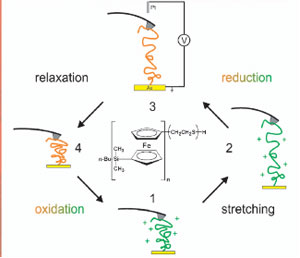| Jan 23, 2006 |
A single molecule working as the nano scale version of the steam engine
|
|
(Nanowerk News) A single molecule working as the nano scale version of the steam engine: that’s the molecular motor developed by a group of UT scientists led by prof. Julius Vancso of the MESA+ Institute for Nanotechnology. Natural ‘motor molecules’, capable of converting chemical energy into movement, have been the source of inspiration for this new synthetic version: a polymer molecule that stretches and shrinks caused by redox reactions. The results appear on the cover of Macromolecular Rapid Communications of Jan. 23, 2006 .
|
 |
The cycle of oxidation, reduction, stretching and shrinking within the PFS-molecule, enabling the molecule to work as a molecular motor. The molecule is fixed on a gold surface and ‘caught’ by the tip of an Atomic Force Microscope. (Source: University of Twente) |
| In nature, some proteins are capable of converting chemical into mechanical energy, by burning ‘fuel molecules’. The synthetic version now presented is a polymer chain, fixed on a surface on one side. Fully stretched, this molecule is a few tens of nanometers long. A cyclic process can be started, in which parts of the chain alternately harden and soften. The result is an amount of mechanical energy, sufficient for driving future nano devices like pumps, valves and levers.
|
|
Just like in nature, redox reactions are the basis for the working principle of the engine: during reduction and oxidation, electrons are interchanged. To stimulate these reactions, iron is introduced within the polymer chain (PFS: polyferrocenydimethylsilane). This iron is alternately oxidized and reduced when the chain is put on a suitable voltage level. This cyclic process causes the soft/hard transitions and the shrinking and stretching of the chain. The researchers now use an atomic force microscope to be able to sense the forces and to get hold of the molecule on the top side. They estimate the efficiency of the conversion to be ten percent. Compared to conversion processes in nature: using photo synthesis, plants convert energy with an efficiency of 13 percent, and the estimated efficiency of the conversion of the chemical energy of food within the human body is about five percent.
|
| A major additional advantage of the new molecular motor presented is that it can be positioned very accurately and controlled on a surface. In this way, it is possible to create a true array of engines and connect the nano devices to them. The distance between the motors can be kept very small. In light-driven nanomotors earlier presented, the minimum distance was limited by the wavelength of the light used, for example.
|

